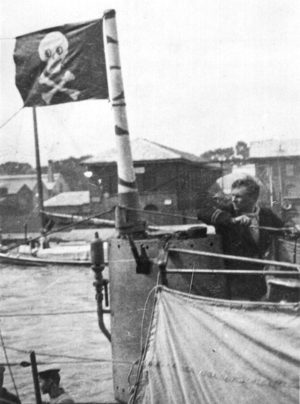HMS H5 facts for kids
class="infobox " style="float: right; clear: right; width: 315px; border-spacing: 2px; text-align: left; font-size: 90%;"
| colspan="2" style="text-align: center; font-size: 90%; line-height: 1.5em;" | 
|} HMS H5, was a British H-class submarine that served in the Royal Navy. She was an important ship during the First World War.
In July 1916, HMS H5 successfully sank a German U-boat called SM U-51. However, her own story ended sadly. On March 2, 1918, she was accidentally hit by a British merchant ship named Rutherglen. The Rutherglen mistook H5 for a German submarine.
Everyone on board HMS H5 died in the accident. Among them was US Navy Lieutenant Earle Wayne Freed Childs. He was observing from the American submarine AL-2. He became the first American submariner to die in the First World War. The place where H5 sank is now a protected site. This is under the Protection of Military Remains Act. A special plaque was placed in Holyhead in 2010 to remember the 26 people who lost their lives.
Submarine Design
HMS H5 was part of the H-class submarines. These submarines were built for the Royal Navy. They were designed to be strong and effective underwater.
H5 was about 150 ft (46 m) long. This is about half the length of a football field! When on the surface, it weighed about 363 t (357 long tons; 400 short tons). When it went underwater, it weighed more, about 434 t (427 long tons; 478 short tons).
The submarine used powerful diesel engines and electric motors to move. On the surface, it could travel up to 13 kn (24 km/h; 15 mph) (knots). Underwater, it was a bit slower, reaching about 10 kn (19 km/h; 12 mph). It could travel a long distance, about 1,600 nmi (2,963 km) on the surface.
For fighting, H5 was equipped with four torpedo tubes at the front. It carried eight torpedoes in total. These were important weapons for attacking enemy ships. The submarine also had a small quick-firing gun on its deck. A crew of 22 sailors worked together to operate the submarine.
Service in World War I
HMS H5 played an important role during the First World War. Submarines were new and powerful tools in naval warfare.
On July 14, 1916, H5 was on patrol. It spotted the German U-boat SM U-51 leaving the Ems River. H5 quickly fired a torpedo. The torpedo hit U-51, causing it to sink. Sadly, 34 German sailors died, but four survived. This was a significant victory for H5 and the Royal Navy.
| History | |
|---|---|
| Name | HMS H5 |
| Builder | Canadian Vickers, Montreal |
| Launched | June 1915 |
| Fate | Sunk, 2 March 1918 |
| General characteristics | |
| Class and type | H-class submarine |
| Displacement |
|
| Length | 150 ft 3 in (45.80 m) |
| Beam | 15 ft 4 in (4.67 m) |
| Propulsion |
|
| Speed |
|
| Range |
|
| Complement | 22 |
| Armament |
|

